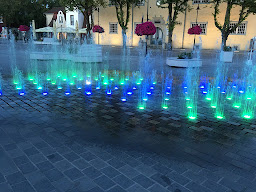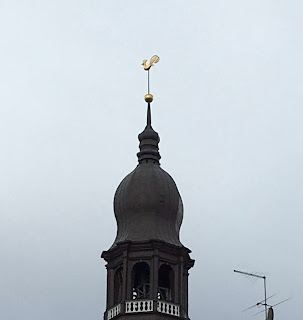 |
| Splash pad in city |
Last week we took some time for R & R in the country of Estonia. The first thing we noticed upon entering Estonia was the language difference with Latvia. Estonian has so many vowels in the words, as you can see by the name of the island. We sometimes saw four vowels together such as "hoiuala." We, of course, didn't know what the words mean, but couldn't even figure out how to pronounce them.
 |
| Kuressaare Fortress |
 |
| Walls surrounding the fortres |
We spent some time on Saaremaa to the west of Estonia. Our main focus was on Kuressaare, the largest city on the island. The most important site to see here was the castle which was first built in early 14th Century. It was built for the protection of the bishops and monks living on the island. Later it became important to the government that was ruling over Saaremaa. With the surrounding walls and bastions, it was a remarkable structure. Today it is a museum.
 |
| St. Lawrence's Lutheran Church |
We also saw several old buildings including a Lutheran church built in the 17th Century. By far, the churches we visited in Estonia were Lutheran. Lutheranism is strong in Estonia as well as Latvia. These parts of Europe were some of the first areas to adopt this religion shortly after 1525 when Martin Luther was working in Wittenberg.
 |
| This hand is too big to shake |
An odd site to see in Kuressaare is a large hand coming out of the wall of the children's museum. We first saw it when we were walking toward the center of town. It is rather striking. I imagine that children are certainly attracted to any building that has this attached.
 |
| Kaali Lake made from the meteorite |
Saaremaa Island is famous because a burning meteorite fell out of the sky 4000 years ago, creating a large crater in a field which is now named Lake Kaali. We stopped to see this crater lake. It's really interesting to see this depressed hole in the ground surrounded by a ridge where the earth was pushed up as the meteor dug the hole. As you can imagine, the ancient folklore from the area tells the story of the sky ripped open and the ground opening up for this big ball of fire.
 |
| The Angla windmills |
The last site that we visited on Saaremaa was the highest point on the island. We knew this because there were several windmills built to grind the grain grown in fields. This was the best location to catch a passing breeze. It was interesting to see large wooden windmills sitting in the field far away from the Netherlands. We found out that they stopped using them during the Soviet times when grinding grain became more centralized in collective farms.
 |
| Scene of the moat around the fortress |
The saddest thing we saw while driving through the countryside was the old cement housing structures left over from the Soviet collective farms. The large sheds and barns were abandoned because the farms were dismantled in the 1990s, but the beautiful countryside was ruined by the empty cement communal housing. Those apartments will stand for hundreds of years because they are cement. They will shout out to the Estonians and Latvians that in the 20th Century the people of those countries lost their freedom and were displaced and forced to live on these farms to work. It's a sight that makes us more thankful for the freedoms that the US Constitution gives us.











Comments
Post a Comment